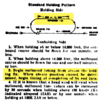RussR
En-Route
When training on VOR holding patterns, we go to all this effort and mental gymnastics to try to make a 1-minute inbound leg. But, historically, why?
The question is not "why" 1-minute. It's "why" the inbound leg.
It would work out about the same if we instead timed the outbound leg for a minute, and didn't worry at all about the inbound leg. Now, I know the outbound leg traditionally doesn't always have an easily-definable start point, but we could just use "wings level" and simplify everything. Yes, wind would affect the shape, but it does that now anyway.
As I type this, one situation occurred to me - that of a holding pattern at the FAF for an ILS or VOR approach. In these situations, it is very helpful to have a inbound leg of at least a minimum length to get everything configured and stabilized. However, also in these situations, the inbound course would generally be into the wind, so a 1-minute outbound leg would result in a longer-then-1-minute inbound leg and therefore more time to get stabilized.
So, is there a historical reason for the timing being done on the inbound leg?
The question is not "why" 1-minute. It's "why" the inbound leg.
It would work out about the same if we instead timed the outbound leg for a minute, and didn't worry at all about the inbound leg. Now, I know the outbound leg traditionally doesn't always have an easily-definable start point, but we could just use "wings level" and simplify everything. Yes, wind would affect the shape, but it does that now anyway.
As I type this, one situation occurred to me - that of a holding pattern at the FAF for an ILS or VOR approach. In these situations, it is very helpful to have a inbound leg of at least a minimum length to get everything configured and stabilized. However, also in these situations, the inbound course would generally be into the wind, so a 1-minute outbound leg would result in a longer-then-1-minute inbound leg and therefore more time to get stabilized.
So, is there a historical reason for the timing being done on the inbound leg?


